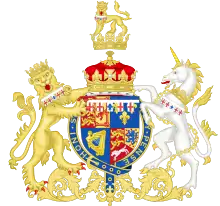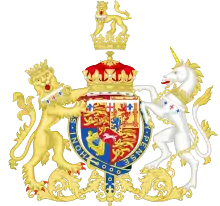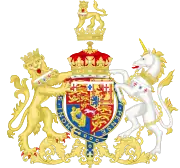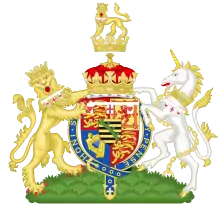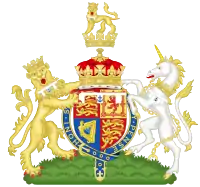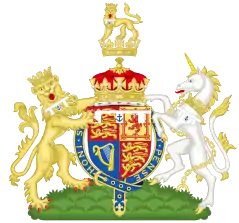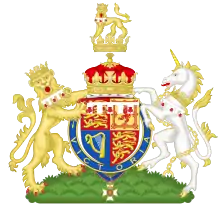Royal dukedoms in the United Kingdom
In the British peerage, a royal duke is a member of the British royal family, entitled to the titular dignity of prince and the style of His Royal Highness, who holds a dukedom. Dukedoms are the highest titles in the British roll of peerage, and the holders of these particular dukedoms are Princes of the Blood Royal. The holders of the dukedoms are royal, not the titles themselves. They are titles created and bestowed on legitimate sons and male-line grandsons of the British monarch, usually upon reaching their majority or marriage.[1] The titles can be inherited but cease to be called "royal" once they pass beyond the grandsons of a monarch. As with any peerage, once the title becomes extinct, it may subsequently be recreated by the reigning monarch at any time.
Royal status of dukedoms
In the United Kingdom, there is nothing intrinsic to any dukedom that makes it "royal". Rather, these peerages are called royal dukedoms because they are created for, and held by, members of the royal family who are entitled to the titular dignity of Prince and the style Royal Highness. Although the term "royal duke" therefore has no official meaning per se, the category "Duke of the Blood Royal" was acknowledged as a rank conferring special precedence at court in the unrevoked 20th clause of the Lord Chamberlain's order of 1520.[2][3] This decree accorded precedence to any peer related by blood to the sovereign above all others of the same degree within the peerage. The order did not apply within Parliament, nor did it grant precedence above the Archbishop of Canterbury or other Great Officers of State such as is now enjoyed by royal dukes. But it placed junior "Dukes of the Blood Royal" above the most senior non-royal duke, junior "Earls of the Blood Royal" above the most senior non-royal earl (cf. Earldom of Wessex), etc. It did not matter how distantly related to the monarch the peers might be (presumably they ranked among each other in order of succession to the Crown). Although the 1520 order is theoretically still in effect, in fact the "Blood Royal" clause seems to have fallen into desuetude by 1917 when George V limited the style of Royal Highness to children and male-line grandchildren of the Sovereign. Thus peers of the blood royal who are neither sons nor grandsons of a sovereign are no longer accorded precedence above other peers.
Under the 20 November 1917 letters patent of King George V, the titular dignity of Prince or Princess and the style Royal Highness were restricted to the legitimate children of a sovereign, the legitimate children of a sovereign's legitimate sons, and the eldest living legitimate son of the eldest legitimate son of a Prince of Wales.[lower-alpha 1]
In 2012, Queen Elizabeth II extended the style Royal Highness from the eldest living legitimate son of the eldest legitimate son of a Prince of Wales to all the children of the eldest son of a Prince of Wales should have and enjoy the style, title and attribute of Royal Highness.
Presuming the current Duke of Gloucester and Duke of Kent are succeeded by their eldest sons, Alexander Earl of Ulster and George Earl of St Andrews, respectively, those peerages (or rather, the 1928 and 1934 creations of them) will cease to be royal dukedoms, instead the title holders will become "ordinary" dukes.[5] The third dukes of Gloucester and Kent will each be styled His Grace because as great-grandsons of George V, they are not princes and are not styled HRH. Similarly, upon the death of Prince Arthur, Duke of Connaught and Strathearn (1850–1942) (the third son of Queen Victoria), his only male-line grandson, Alastair, Earl of MacDuff (1914–43), briefly succeeded to his peerages and was styled His Grace. Before the 1917 changes, his style and title had been His Highness Prince Alastair of Connaught.
Current royal dukedoms
The current royal dukedoms, held as principal titles, in order of precedence, are:
| Dukedom | Holder | Year created | Subsidiary titles |
|---|---|---|---|
| Duke of Edinburgh | Prince Philip | 1947 | Earl of Merioneth Baron Greenwich |
| Duke of Cambridge | Prince William | 2011 | Earl of Strathearn Baron Carrickfergus |
| Duke of Sussex | Prince Harry | 2018 | Earl of Dumbarton Baron Kilkeel |
| Duke of York | Prince Andrew | 1986 | Earl of Inverness Baron Killyleagh |
| Duke of Gloucester | Prince Richard[6] | 1928 | Earl of Ulster Baron Culloden |
| Duke of Kent | Prince Edward[7] | 1934 | Earl of St Andrews Baron Downpatrick |
The following dukedoms are currently held as secondary titles by members of the royal family:
- Duke of Cornwall is a secondary title of the Sovereign's eldest son in England,[1][8] currently held by Charles, Prince of Wales. In addition to the dukedom of Cornwall, a peerage, the heir apparent also enjoys a life interest in the Duchy of Cornwall.
- Duke of Rothesay is a secondary title of the Sovereign's heir apparent in Scotland, currently held by Prince Charles,[1] who is properly called "HRH The Prince Charles, Duke of Rothesay" (rather than "HRH The Prince of Wales") in Scotland.
With the exceptions of the dukedoms of Cornwall and Rothesay (which can only be held by the eldest living son of the sovereign who is also the heir-apparent), these dukedoms are hereditary according to the letters patent that created them.[1] Those patents each contain the standard remainder to "heirs male of his body".
By law the British monarch also holds, and is entitled to the revenues of, the Duchy of Lancaster. Within the borders of the County Palatine of Lancashire, therefore, Elizabeth II is hailed as "The Queen, The Duke of Lancaster" (even when the monarch is a Queen regnant, by tradition she does not use the title Duchess).[1] However, legally the monarch is not the Duke of Lancaster: peerages are in origin held feudally of the sovereign who, as the fount of honour, cannot hold a peerage of him- or herself. The situation is similar in the Channel Islands, where the monarch is addressed as Duke of Normandy, but only in accordance with tradition. He or she does not hold the legal title of Duke of Normandy.
Former royal dukedoms
The following is a list of dukedoms previously created for members of the royal family, but which have subsequently merged in the crown, become extinct or have otherwise ceased to be royal dukedoms.
Extinct dukedoms
| Title | Status | Notes |
|---|---|---|
| Duke of Albemarle | Deprived in 1399. | Non-royal dukedom created in 1660 (extinct 1688); non-royal Earldom of Albemarle (created 1697) is extant. |
| Duke of Clarence[1] | Forfeit in 1478. | Earldom of Clarence (created 1881) is a subsidiary title of the suspended Dukedom of Albany. |
| Duke of Clarence and Avondale | Extinct in 1892. | |
| Duke of Clarence and St Andrews | Merged in the crown in 1830. | Earldom of St Andrews (created 1934) is a subsidiary title of the extant Dukedom of Kent. |
| Duke of Connaught and Strathearn[1] | Extinct in 1943. | Earldom of Strathearn (created 2011) is a subsidiary title of the extant Dukedom of Cambridge. |
| Duke of Cumberland[1] | Extinct in 1765. | |
| Duke of Cumberland and Strathearn | Extinct in 1790. | Earldom of Strathearn (created 2011) is a subsidiary title of the extant Dukedom of Cambridge. |
| Duke of Gloucester and Edinburgh | Extinct in 1834. | Currently separate Dukedoms. |
| Duke of Hereford | Merged in the crown in 1399 | Non-royal Viscountcy of Hereford (created 1550) is extant. |
| Duke of Kendal[1] | Extinct in 1667. | Non-royal dukedom created in 1719 (extinct 1743). |
| Duke of Kent and Strathearn | Extinct in 1820. | Earldom of Strathearn (created 2011) is a subsidiary title of the extant Dukedom of Cambridge. |
| Duke of Kintyre and Lorne | Extinct in 1602 | Non-royal Marquessate of Kintyre and Lorne (created 1701) is a subsidiary title of the extant Dukedom of Argyll |
| Duke of Ross | Extinct in 1515 | |
| Duke of Windsor | Extinct in 1972. | The title that was given to King Edward VIII after his abdication. Non-royal Barony (created 1529) and Viscountcy of Windsor (created 1905) are subsidiary titles of the extant Earldom of Plymouth. Non-royal Earldom of Windsor (created 1796) is a subsidiary title of the extant Marquessate of Bute. |
| Duke of York and Albany | Extinct in 1827. |
Extinct as royal dukedoms
| Title | Royal creation | Current status |
|---|---|---|
| Duke of Bedford | Extinct in 1495. | Non-royal dukedom created in 1694 is extant. |
| Duke of Norfolk | Extinct in 1483. | Non-royal dukedom created in 1483 is extant. |
| Duke of Somerset | Extinct in 1500. | Non-royal dukedom created in 1547 is extant. |
Suspended dukedoms
Under the Titles Deprivation Act 1917 the holders of the following dukedoms, who were simultaneously British princes and members of royal and princely families of Germany, were deprived of their British titles, having sided with Germany during First World War. The Act provides that a successor of a person thus deprived of a peerage can petition the Crown for revival of the title. No such descendant has done so as of 2020.
| Title | Created | Deprived holder | Current claimant |
|---|---|---|---|
| Duke of Albany[1] | 1881 | Charles Edward, Duke of Saxe-Coburg and Gotha | Prince Hubertus of Saxe Coburg and Gotha |
| Duke of Cumberland and Teviotdale | 1799 | Ernest Augustus, Crown Prince of Hanover | Prince Ernst August of Hanover |
Vacant dukedoms
| Title |
|---|
| Duke of Clarence |
| Duke of Connaught |
| Duke of Kendal |
| Duke of Ross |
| Duke of Windsor |
Royal dukedoms created since 1726
Forms of address
- Address: His/Her Royal Highness The Duke/Duchess of (X)
- Speak to as: Your Royal Highness
- After: Sir/Madam
Coronet
While non-royal dukes are entitled to a coronet of eight strawberry leaves, to bear at a coronation and on his coat of arms, royal dukes are entitled to princely coronets (four cross pattées alternating with four strawberry leaves). The coronets of the royal family are dictated by letters patent. The Duke of York bears by letters patent, and the Duke of Edinburgh was granted in 1957 use of, the coronet of a child of the sovereign (four crosses patées alternating with four fleurs-de-lis),[28] while the Duke of Cornwall and of Rothesay has use of the Prince of Wales Coronet, the Duke of Cambridge and the Duke of Sussex the coronet of a child of the heir-apparent, and the current Dukes of Gloucester and of Kent, as grandsons of a sovereign bear the corresponding coronet of a royal duke. The Duke of Edinburgh was first created a royal duke in 1947 by George VI and later had his status elevated to that of a full Prince of the United Kingdom in 1957 by Elizabeth II.
At coronations, apart from the differentiation of princely coronets from ducal coronets, a royal duke is also entitled to six rows of ermine spots on his mantle, as opposed to the four rows borne by an "ordinary" duke.
 Coronet of the Duke of Cornwall and Rothesay
Coronet of the Duke of Cornwall and Rothesay Coronet of the Dukes of Edinburgh and of York
Coronet of the Dukes of Edinburgh and of York Coronet of the Dukes of Cambridge and Sussex
Coronet of the Dukes of Cambridge and Sussex Coronet of the Dukes of Gloucester and of Kent
Coronet of the Dukes of Gloucester and of Kent
See also
Notes
- This rule would have meant that Prince Charles and Princess Anne would not, from birth, have had royal status or be called Prince and Princess, as they were the children of the daughter of the sovereign. So immediately prior to the birth of Princess Elizabeth's first child, King George VI issued letters patent dated 22 October 1948 declaring that Princess Elizabeth's children with Philip Mountbatten, Duke of Edinburgh would take royal status and be called Prince or Princess from birth.[4]
- He died without legitimate male heirs.
- The 2nd Duke died without legitimate male heirs.
- The 2nd Duke died without legitimate male heirs as his marriage was not in accordance with the Royal Marriages Act 1772. If the marriage was recognised by law, the title would have been extinct in 1960.
- The 2nd Duke died without legitimate male heirs.
References
- Montgomery-Massingberd, Hugh, ed. (1973). "Appendix C: Titles Traditionally Associated with the Royal Family". Burke's Guide to the Royal Family. London: Burke's Peerage Ltd/Shaw Publishing Co. pp. 183, 336–337. ISBN 0-220-66222-3.
- Velde, Francois. "Order of Precedence in England and Wales". Heraldica.org. Retrieved 2010-11-17.
- Squibb, G.D. (1981). "The Lord Chamberlain's Order of 1520, as amended in 1595". Order of Precedence in England and Wales. Oxford, England: Clarendon Press. pp. 99–101.
- "No. 38452". The London Gazette. 9 November 1948. p. 5889.
- Eilers, Marlene. Queen Victoria's Descendants. Rosvall Royal Books, Falkoping, Sweden, 1997. p. 45. ISBN 91-630-5964-9
- "The Duke of Gloucester". The official website of the British Monarchy.
- "The Duke of Kent". Official website of the British Monarchy.
- "The Prince of Wales: styles and titles".
- "No. 9987". The London Gazette. 29 March 1760. p. 1.
- "No. 10470". The London Gazette. 13 November 1764. p. 1.
- "No. 12598". The London Gazette. 23 November 1784. p. 2.
- "No. 13097". The London Gazette. 16 May 1789. p. 377.
- "No. 15126". The London Gazette. 20 April 1799. p. 372.
- "No. 15429". The London Gazette. 21 November 1801. p. 1.
- "No. 23119". The London Gazette. 25 May 1866. p. 3127.
- "No. 24098". The London Gazette. 26 May 1874. p. 1.
- "No. 24977". The London Gazette. 24 May 1881. p. 1.
- "No. 26055". The London Gazette. 24 May 1890. p. 1.
- "No. 26291". The London Gazette. 25 May 1892. p. 1.
- "No. 31931". The London Gazette. 4 June 1920. p. 6313.
- "No. 33371". The London Gazette. 30 March 1928. p. 2321.
- "No. 34904". The London Gazette. 9 October 1934. p. 6365.
- "No. 34350". The London Gazette. 15 November 1936. p. 8115.
- "No. 38128". The London Gazette. 20 November 1947. pp. 5495–5496.
- "No. 50606". The London Gazette. 23 July 1986. p. 1.
- "No. 59798". The London Gazette. 1 June 2011. p. 10297.
- Prince Harry and Ms. Meghan Markle: Announcement of Titles, 19 May 2018
- "No. 41009". The London Gazette. 22 February 1957. p. 1209
.svg.png.webp)


